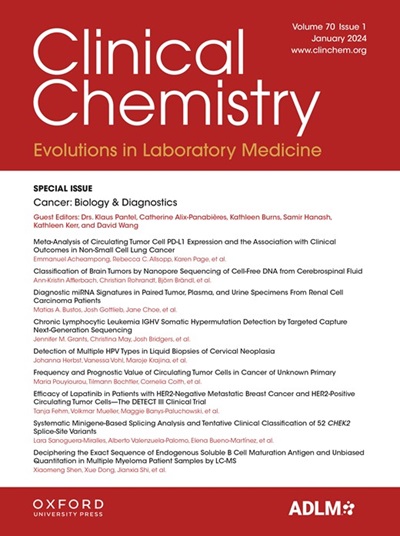B-015 用 Diasorin 的免疫测定分析仪 LIAISON® XL 对人体 EDTA 血浆中的 MR-proADM 生物标记物进行分析验证
IF 7.1
2区 医学
Q1 MEDICAL LABORATORY TECHNOLOGY
引用次数: 0
摘要
背景肾上腺髓质素(ADM)是一种由 52 个氨基酸组成的强效血管扩张肽,属于降钙素肽家族。中段前ADM(MR-ProADM)是ADM的前体,与ADM的循环比例为1:1,按比例代表其水平和活性。在多种疾病状态下,包括心血管系统功能障碍和败血症,都会出现 ADM 循环浓度升高的情况。然而,由于 ADM 的半衰期短、存在结合蛋白及其物理特性,对其进行可靠的定量分析一直受到阻碍。因此,MR-proADM 的定量是一个更合适的选择。生物标志物 MR-proADM 已被证明是预测下呼吸道感染、败血症、尿路感染和肾病患者预后的准确标志物。本研究的目的是验证 LIAISON® Brahms MR-proADMTM 在 Liaison® XL(DiaSorin)上的计量学特性和定量测量范围的线性,正如制造商所宣称的那样。方法 采用制造商提供的两级质量控制(QC)(x̄L=1,19 nmol/L 和 x̄H=5,48 nmol/L)和活动性脓毒症患者的残留 EDTA 血浆样本进行验证。评估内容包括- 检测能力(包括定量限 (LoQ) 和检测限 (LoD),以制造商规定的浓度(分别为 0.21 nmol/L 和 0.09 nmol/L)在 4 次运行中重复测量 3 份样本)。- 内部精密度(CV,%)和准确度(偏差,%),测量每个质控水平的 10 个重复样本;运行间精密度(CV,%)和准确度(偏差,%),测量 5 次运行中每个质控水平的 5 个重复样本。- 定量测量范围的线性(通过混合高浓度样本 XH=9.64 nmol/L 和低浓度样本 XL=0.59 nmol/L 制备六个中间样本;一式三份进行测量)。所有研究均按照临床实验室标准协会指南的建议进行。统计分析使用 Microsoft Excel® 2016 进行。结果 所有稀释样品的检测结果均显示信号(RLU)高于不含分析物的样品,因此 LoD 得到验证。LoQ浓度下的精密度为26.7%(接受标准设定为<20%)。在低控制水平(L1)和高控制水平(L2)下,运行内精密度的误差率分别为 4.3% 和 2.0%,运行间精密度的误差率分别为 6.8% 和 7.9%。L1 和 L2 的平均偏差分别为 3.60% 和 4.23%,符合接受标准(<8%)。线性范围为 0.59 至 9.64 nmol/L(R2 = 0.995)。除最低浓度样品(接近定量限)外,预期值与获得值之间的偏差在定量测量范围内均小于 7%。结论 我们的研究表明,LoD、精确度、偏差和线性范围均符合制造商宣称的计量特性。虽然没有验证 LoQ,但它超出了脓毒症患者的临床决策值(< 2.25 nmol/L),因此不被认为是临床实践的限制因素。此外,Liaison XL® 平台允许我们配置一个紧急协议电路(24/7),TAT 为 35 分钟。本文章由计算机程序翻译,如有差异,请以英文原文为准。
B-015 Analytical Verification of MR-proADM Biomarker in Human EDTA Plasma on Immunoassay Analyzer LIAISON® XL of Diasorin
Background Adrenomedullin (ADM) is a potent vasodilator peptide of 52-aminoacid belonging to the calcitonin family of peptides. Midregional pro-ADM (MR-ProADM) is a precursor for ADM that circulates is in a 1:1 ratio with it, and proportionally represents its levels and activity. Increased ADM circulating concentrations have been described for several disease states, including dysfunction of the cardiovascular system and sepsis. However, reliable ADM quantification has been hampered by the short half-life, the existence of a binding protein, and its physical properties. Hence, quantificacion of MR-proADM represents a more suitable option. The biomarker MR-proADM has been shown to be an accurate prognostic marker for outcome prediction in patients with lower respiratory infections, sepsis, urinary tract infections, and kidney disease. The objective of this study was the verification of the metrological characteristics and the verification of the linearity of quantitative measurement range, as declared by the manufacturer, of the LIAISON® Brahms MR-proADMTM on Liaison® XL (DiaSorin). Methods The verification was performed with two levels of quality controls (QC) from the manufacturer (x̄L=1,19 nmol/L and x̄H=5,48 nmol/L), and residual EDTA plasma samples from patients with an active sepsis code. The evaluation included the assessment of: • Detection capability (including limit of quantification (LoQ) and limit of detection (LoD), measuring three samples at the manufacturer's stated concentration (0.21 nmol/L and 0.09 nmol/L, respectively) in duplicate within 4 runs). • Precision (CV, %) and accuracy (bias, %) within, measuring 10 replicates of each QC level; and between run, measuring 5 replicates for each QC level within 5 runs. • Linearity of the quantitative range of measurement (six intermediate samples prepared by mixing a high concentration sample- XH=9.64 nmol/L- and a low concentration sample, XL=0.59 nmol/L; measured in triplicate). All studies were performed in accordance with the recommendations of the Clinical Laboratory Standards Institute guidelines. Statistical analysis was performed using Microsoft Excel®, 2016. Results All results with diluted samples presented a signal (RLU) higher than that detected in samples without analyte, so the LoD was verified. The precision at the LoQ concentration was 26.7% (acceptance criteria was set as <20%). CV for within-run precision were 4.3% and 2.0% and for between-run precision 6.8% and 7.9% for low (L1) and high (L2) control level, respectively. The average bias was 3.60% for L1 and 4.23% for L2, meeting acceptance criteria (<8%). Linearity was confirmed between 0.59 and 9.64 nmol/L (R2 = 0.995). The biases between the expected and the obtained value were ≤7% through the quantitative range of measurement, except for the lowest concentration sample (close to the quantitation limit). Conclusions Our study showed good compliance with the metrological characteristics declared by the manufacturer for LoD, precision, bias and linearity range. Although the LoQ was not verified, it is outside the clinical decision value in septic patients (< 2.25 nmol/L) and it is not deemed a limitation for clinical practice. Additionally, the Liaison XL® platform permits us to configure an emergency protocol circuit (24/7) with a TAT of 35 min.
求助全文
通过发布文献求助,成功后即可免费获取论文全文。
去求助
来源期刊

Clinical chemistry
医学-医学实验技术
CiteScore
11.30
自引率
4.30%
发文量
212
审稿时长
1.7 months
期刊介绍:
Clinical Chemistry is a peer-reviewed scientific journal that is the premier publication for the science and practice of clinical laboratory medicine. It was established in 1955 and is associated with the Association for Diagnostics & Laboratory Medicine (ADLM).
The journal focuses on laboratory diagnosis and management of patients, and has expanded to include other clinical laboratory disciplines such as genomics, hematology, microbiology, and toxicology. It also publishes articles relevant to clinical specialties including cardiology, endocrinology, gastroenterology, genetics, immunology, infectious diseases, maternal-fetal medicine, neurology, nutrition, oncology, and pediatrics.
In addition to original research, editorials, and reviews, Clinical Chemistry features recurring sections such as clinical case studies, perspectives, podcasts, and Q&A articles. It has the highest impact factor among journals of clinical chemistry, laboratory medicine, pathology, analytical chemistry, transfusion medicine, and clinical microbiology.
The journal is indexed in databases such as MEDLINE and Web of Science.
 求助内容:
求助内容: 应助结果提醒方式:
应助结果提醒方式:


